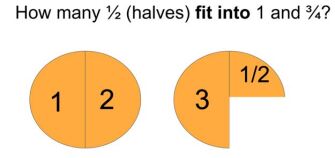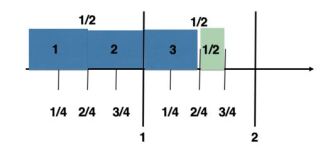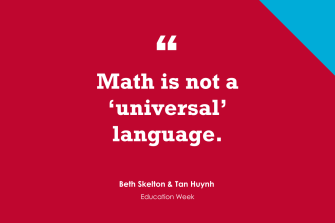Today’s post begins a three-part series on teaching math to English-language learners.
‘4 Essential Messages’
Isabel Becerra is the sheltered-instruction facilitator for the multilingual programs department in the Garland ISD in Texas. She was born in Bolivia and has been an educator since 1992. She is a passionate advocate for emergent bilingual learners:
As an educator for the past 28 years, I have seen firsthand the impact we make in the learning process of our emergent bilingual students by only providing the right supports, and scaffolds, to make content comprehensible and meaningful for them, even if they are at beginning levels of English proficiency.
In my role as the sheltered-instruction facilitator, I serve as an active and passionate advocate who seeks to provide an equitable learning environment for all learners. I do this by promoting the sheltered-instruction approach as a learning framework for best practices that offers students equitable opportunities to develop content and language. This second-language acquisition method is implemented within all grade levels and content areas to ensure that emergent bilinguals are fully engaged in meaningful and rigorous learning.
When we teach our emergent bilingual students math, we do need to understand that we are teaching another language. Math itself is a second language to many, due to the number of new terms, concepts, and process that need to be learned. Our emergent bilingual students come with limited background knowledge, cultural and linguistic differences, and they bring diverse learning experiences, which makes learning math too challenging for them.
When we don’t connect and scaffold instruction for our EBs, we are setting them up for failure. We need to provide a language-rich and interactive learning environment for our students to have enough background to make sense of what they are learning. We use the sheltered-instruction research from Seidlitz Education, The 7 Steps to a Language-Rich and Interactive Environment as our framework. We equip teachers with instructional strategies that will allow all students to have access to content.
Some of the strategies that I recommend using with our EBs in math classes are:
1. To make academic vocabulary and concepts explicit and visual, we encourage our teachers to use Step 5, use visual and vocabulary strategies, to make content material comprehensible for emergent bilinguals by building context for vocabulary and incorporating supporting visuals. Visual and vocabulary supports assist in mastering grade-level objectives; strategies are implemented intentionally to make the learning accessible to all students.
2. To focus on academic and class discussions, EBs need to internalize content so that they can externalize it. This means we need to plan for multiple opportunities for students to speak math. Step 6, students participate in structured conversations, is one way that will allow students to process learning through structured discussions while developing academic language. Peer conversations support academic language use while content and language are equally developed in all learners.
One very common strategy in this step is the use of (Question, Signal, Stem, Share, Assess). This strategy is helpful to scaffold a conversation, and it helps develop a sense of community among peers as well as it lowers the affective filter of our EBs when asked to discuss or respond to a question. Whether you are a kindergarten math teacher or a high school algebra teacher, I challenge YOU to try this amazing technique with your students.
3. Step 2, speak in complete sentences, will provide supports for students to speak at an academic level when discussing their learning. One way to do this is by using sentence stems for students to form complete responses in a way that they can adopt new language structures to use independently.
Instructional strategies are all about the student and equity in learning. To ensure that we approach our students with this mindset, we must consider what message our instruction is sending to them. How learning is delivered says a great deal about our attitudes, values, and beliefs.
The four essential messages that emergent bilinguals must hear from every educator are:
- You are important.
- What we are learning is important.
- You can do it.
- We will not give up on you!

Visuals and Manipulatives
Beth Skelton has over 30 years of experience as a language educator in many different contexts. She currently provides professional development, coaching, and consulting with schools around the world focused on providing equitable education for multilingual learners.
Tan Huynh is an international educator specializing in language acquisition. He advocates equitable learning for multilinguals through his blog, podcast, webinars, and books.
Tan and Beth are co-authors of Long-Term Success for Experienced Multilinguals.
Math is not a “universal” language as some may suggest; the language for math is just as challenging for English-learners as any other content class. In fact, math teacher Concepcion Molina even titled his book .
We believe math classes provide a wonderful opportunity to teach both math skills and language if teachers design lessons following three essential principles: 1) enhance comprehension of the concepts; 2) increase student-to-student interactions; and 3) teach academic language.
Enhance Comprehension
Before introducing an algorithm for solving problems, we recommend that students have the opportunity to simply make sense of the concept and problems. Providing students with practical examples of the math concept in contexts connected to students’ lives is a great starting place for enhancing their understanding of the math concept. For example, when teaching students to divide by fractions, first provide them with a practical scenario like the following:
Class, I would like to bake you some cookies. The recipe calls for 1 and 3/4 cups of flour, but I only have a 1/2-cup measuring cup. How many 1/2 cups will I need to make 1 and 3/4 cups of flour? Providing examples of 1 cup and 1/2 cup measuring cups will help all students see the problem. They can also experiment with scooping 1/2 cups of flour to see how many 1/2 cups make the total of 1 and 3/4 cups.
Visuals also enhance comprehension by linking unfamiliar words with physical objects. For example, many teachers think about using pizzas to visually represent 1 and 3/4 divided by ½. We can visually show students what the concept looks by showing pizzas and asking: How many 1/2s fit into 1 and 3/4 pizzas?

Image by Beth Skelton
Manipulatives, objects that can be moved around, can also help students understand mathematical concepts. In the example of dividing by fractions, students can use 1/2- inch paper markers and a number line to figure out how many 1/2 markers are needed to reach 1 and 3/4 on the number line.

Image by Beth Skelton
Increase Student-to-Student Interaction
While math is often done alone, when it becomes interactive, multilingual learners develop deeper understanding of the math concepts as well as the academic language to speak like mathematicians. We encourage teachers to structure these student-to-student interactions so that everyone has an equitable opportunity to explain their thinking using math-specific language.
Many of are especially well-suited for the math class. For example, students could work in teams to figure out how many 1/2 cups of flour they would need to make the cookies, how many 1/2 pizzas fit into 1 and 3/4 pizzas, and how many 1/2-inch markers would make 1 and 3/4 on the number line. In teams, they can explain their thinking as they work with the manipulatives and visuals.
After teachers introduce the algorithm for solving problems, students need plenty of practice opportunities. When students work in partnerships to practice solving problems using a structure like , they practice both the math skill and math language.
In this structure, the “Sage” tells the “Scribe” what to write to solve the problem. In a way, the “Sage” thinks aloud stating the steps for solving the practice problems, and the “Scribe” has the opportunity to listen, think about the steps, and write the solutions with support. The partners take turns with each role. Multilingual learners can be the “Scribe” first, which allows them to hear the steps from their partner first, before they take a turn describing the steps. Word banks and sentence frames support all students during this structured interaction.
Teach Academic Language
Math classes are filled with linguistic challenges, but they are surmountable when we teach the language mathematicians use. Most teachers spend some class time focused on teaching math-specific terms like property, common denominator, and place value, but they may not realize that multilingual learners may also grapple with other vocabulary challenges such as:
● Multiple meaning words like table, mean, and round.
● Homophones like sum/some; sine/sign; and two/to/too.
● Minimal pairs such as 30 and 13.
● Prepositions: The temperature fell from 50 degrees; the temperature fell to 50 degrees; or the temperature fell by 50 degrees.
Awareness of the linguistic challenges multilingual learners face in math class is an important first step to providing necessary supports. Some of the most effective supports include:
• Labeled visuals
• Visual word banks
• Written numbers (not just verbal numbers)
• Many opportunities to hear and practice words in context
Enhancing comprehension, increasing interaction, and teaching academic language can solve the problem of math for multilingual learners. Math is not just the study of numbers but also the language wrapped around those numbers!

‘Four Mindsets’
Jim Ewing is an associate professor and author of the book Jim provides motivating, relevant, and strategy-driven workshops for teachers that get results. To learn more about his workshops and book, go to EwingLearning.com:
Multilingual learners are not doing well in mathematics as a whole. This is not because they are not capable but because we are not meeting their needs (Ewing, 2020). Solely focusing on strategies is not enough—we also need to consider our mindsets. If educators do not have the proper mindsets, then using strategies will not be effective.
Below are four mindsets that we should have to accompany strategies.
Position multilingual learners to be successful. One strategy often used by educators is to assign helpers to assist multilingual learners, but this can position multilingual learners as weak (Chval et al., 2021). We can better position their success by ensuring that multilingual learners are helping other students, too.
We can ask multilingual learners questions about their strengths so other students see them as capable mathematicians. Educators can revoice students so they have mathematical voices in the class. Merely calling students “multilingual learners” instead of “English-language learners” can let other students know how talented they are for knowing more than one language. Regardless of the strategies we use, we need to position multilingual learners to be successful mathematicians.
Be culturally responsive. Using visuals can be an effective strategy, but what are multilingual learners visualizing? If multilingual learners cannot visualize themselves in our math curriculum, they will not be successful. If the visuals we use do not look like the multilingual students in our classes, then they may feel that they do not belong in the math discourse. Another strategy is to engage students at the beginning of the math lesson by reading books to them, but if the characters in the book are not about multilingual learners, these students will not be hooked.
Focus on persevering, not working fast. A third mindset is to focus on persevering over working fast. This is important for many students but imperative for multilingual learners who are often translating from their first language. Using manipulatives is a useful strategy for building concepts and providing access, but if multilingual learners are not also provided enough time, using that strategy will fall short.
Have high expectations. There are many strategies for providing multilingual learners access to the content, such as using gestures, but if we have low expectations for students, this will be counterproductive. If we apply the first three mindsets: position multilingual learners to be successful, be culturally responsive, and focus on persevering, they can engage in challenging math. Thus, it makes sense to raise our expectations for multilingual learners.
We can meet the needs of multilingual learners, and they can be successful, but just learning strategies is not enough. Let’s also change our mindsets and celebrate multilingual learners’ success in mathematics.
References
Chval, K.B., Smith, E., Trigos-Carrillo, L., & Pinnow, R.J. (2021). Teaching math to multilingual students: Positioning English learners for success. Corwin Press.
Ewing, J. (2020). Math for ELLs. As easy as uno, dos, tres. Rowman & Littlefield.

Thanks to Isabel, Beth, Tan, and Jim for contributing their thoughts!
The new question of the week is:
What instructional strategies do you recommend using with English-language learners in math classes?
Consider contributing a question to be answered in a future post. You can send one to me at lferlazzo@epe.org. When you send it in, let me know if I can use your real name if it’s selected or if you’d prefer remaining anonymous and have a pseudonym in mind.
You can also contact me on Twitter at .
Education Week has published a collection of posts from this blog, along with new material, in an e-book form. It’s titled .
Just a reminder; you can subscribe and receive updates from this blog via (The RSS feed for this blog, and for all Ed Week articles, has been changed by the new redesign—new ones are not yet available). And if you missed any of the highlights from the first 11 years of this blog, you can see a categorized list below.
- It Was Another Busy School Year. What Resonated for You?
- How to Best Address Race and Racism in the Classroom
- 69��ý Just Let Out, But What Are the Best Ways to Begin the Coming Year?
- Classroom Management Starts With Student Engagement
- Teacher Takeaways From the Pandemic: What’s Worked? What Hasn’t?
- The School Year Has Ended. What Are Some Lessons to Close Out Next Year?
- Student Motivation and Social-Emotional Learning Present Challenges. Here’s How to Help
- How to Challenge Normative Gender Culture to Support All 69��ý
- What 69��ý Like (and Don’t Like) About School
- Technology Is the Tool, Not the Teacher
- How to Make Parent Engagement Meaningful
- Teaching Social Studies Isn’t for the Faint of Heart
- Differentiated Instruction Doesn’t Need to Be a Heavy Lift
- How to Help 69��ý Embrace 69��ý. Educators Weigh In
- 10 Strategies for Reaching English-Learners
- 10 Ways to Include Teachers in Important Policy Decisions
- 10 Teacher-Proofed Strategies for Improving Math Instruction
- Give 69��ý a Role in Their Education
- Are There Better Ways Than Standardized Tests to Assess 69��ý? Educators Think So
- How to Meet the Challenges of Teaching Science
- If I’d Only Known. Veteran Teachers Offer Advice for Beginners
- Writing Well Means Rewriting, Rewriting, Rewriting
- Christopher Emdin, Gholdy Muhammad, and More Education Authors Offer Insights to the Field
- How to Build Inclusive Classrooms
- What Science Can Teach Us About Learning
- The Best Ways for Administrators to Demonstrate Leadership
- Listen Up: Give Teachers a Voice in What Happens in Their 69��ý
- 10 Ways to Build a Healthier Classroom
- Educators Weigh In on Implementing the Common Core, Even Now
- What’s the Best Professional-Development Advice? Teachers and 69��ý Have Their Say
- Plenty of Instructional Strategies Are Out There. Here’s What Works Best for Your 69��ý
- How to Avoid Making Mistakes in the Classroom
- Looking for Ways to Organize Your Classroom? Try Out These Tips
- Want Insight Into Schooling? Here’s Advice From Some Top Experts
I am also creating a .





